Patients and staff celebrate Hatfield move
The lobby of the Mark O. Hatfield Clinical Research Center was relatively still and silent on Saturday morning, April 2. A few people lingered at the café tables by the fountain, while others quietly prepared for the day ahead—wiping countertops, sweeping hallways, and turning on computers. The stillness was soon broken by the muffled sound of wheels rolling across the tile floors somewhere in the south end of the first floor. It echoed through the Clinical Center lobby. “The patient is on his way,” someone hollered over a radio.
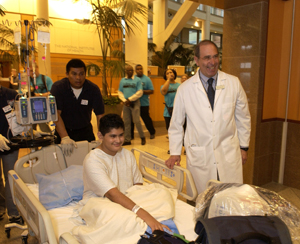
|
Dr. John I. Gallin welcomes patient Marcos Arrieta to the pediatrics unit in the new Hatfield Clinical Research Center. Arrieta was the first pediatric patient to make the move into the new building.
|
Every person who had been answering phones, mopping floors, scrubbing desks, or checking files stopped what they were doing, walked out into the lobby, and turned to look in the direction of the growing clamor. Doctors, nurses, hospitality staff, housekeepers, construction workers and visitors all strained to get a glimpse of the convoy heading towards the pediatric unit. As the sound grew louder and louder, people's faces changed from looks of expectation to welcoming smiles. The Clinical Center's first pediatric patient had arrived. Marcos Arrieta, laying in his bed, was escorted by a crew of nurses, volunteers, other staff and his mother, Maria, as he made his way from the Warren Grant Magnuson building to the bright, new rooms of the Hatfield Center where he was formally welcomed by Dr. John I. Gallin, CC director, as the new pediatric unit's first patient.
Arrieta shyly smiled as Gallin shook his hand and began pointing out some of the new features in the boy's room, including the flat-screen television that also serves as a computer monitor, the keyboard and mouse and the glow-in-the-dark animal footprints on the ceiling.
Following Arrieta's arrival, the new pediatrics unit and Gallin welcomed four more patients and their family members: Derek Aldona Reyes, Valeria Rivero, Kathryn Yokoyama and Nicole Hofhine.
They were so excited about the move. A couple of them kept asking, ‘Can we go? Can we go now?' all through the night,” says nurse Siu-Ping Ng as she watches the beds be wheeled in.
Hofhine's mother, Michelle, walked into the room and immediately exclaimed, “Look at this view! You can see the Children's Inn right across the street,” as she looked out the large room window. Nicole and her mother have been coming to the Clinical Center for almost ten years and had been anxious to see the new building. “We were here when they broke ground for this building,” Michelle says. “It's great to finally see the inside.” Nicole seemed pleased with her room as well as she arranged her two stuffed dogs beside her in bed and smiled at the sight of her very own computer keyboard.
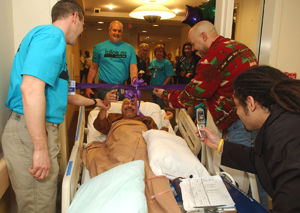
|
The neurology unit staff welcome their first patient, Erias Hyman, with a ribbon-cutting ceremony. Clinical Center staff member Charley McGarvey, Rehabilitation Medicine Department (center), joins Hyman’s family members (right) for the mini-celebration.
|
The pediatric unit was not the only area of the hospital alive with movement and transitions. Hundreds of staff, movers and volunteers were on hand to coordinate the transport of 89 individual patients from the old building to the new. Proudly wearing their bright blue T-shirts with the “Follow Me to the CRC” logo designed especially for the Clinical Center move, volunteers and staff tended to every need—whether it was moving furniture, cleaning new work stations, stocking pharmacy shelves, preparing patients' meals for the day, translating for non-English-speaking patients and their families, reassuring patients, or communicating updates from the move headquarters in the Medical Board Room.
The most challenging part of the move was that it had to be completed in one day, but it was the only realistic option. Senior Nurse Executive Laura Chisholm, who served as co-chair of the relocation task force, explains, “Logistically, we could not split our patient services between two locations. We had to move all of our equipment and patients at the same time, which made it all the more challenging. Thankfully, we had a great team working together, so it made the whole move go exception-ally well.”
For months leading up to the move date, employees participated in a multitude of simulated tests, drills and exercises to prepare them for any situation that might arise on the move date and the days following. The relocation task force led practice walks through various routes from the Magnuson to Hatfield building many times, looking for anything that may interfere with the movement of patient beds and determining the best path to efficiently move arriving patients. “We have been through every scenario; prepared for every possible thing that could happen,” says one volunteer. “We're ready. No one is nervous; we're just excited.”
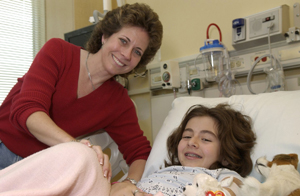
|
Pediatric patient Nicole Hofhine and her mother, Michelle, have been coming to the Clinical Center for ten years from their home in Camarillo, Calif. Both were very excited to see the new rooms in the Hatfield Center.
|
The move completed ahead of schedule at 3:38 p.m., but not without a few obstacles along the way. “The facilities staff did an amazing job,” Chisholm says. “Throughout the day, they fixed a broken elevator, tended to two small floods, built a ramp to allow beds to travel over a path that had a bump in it, took care of door access issues, and finished last minute housekeeping needs.”
Even in spite of the day's challenges, the consensus among staff, patients and their families was one of positive excitement. Family members joined doctors and nurses as they all snapped photos of loved ones moving into the sparkling new facilities. Patients shook hands with the movers who had pushed their beds, and smiled and waved to staff as their beds progressed down the hallways.
The move was one of great historical significance for NIH, but it was also a memorable day for those who were present.
To those gathered to kick-off the moving day's events, Gallin said, “Getting to this point has been an adventure—like climbing Mt. Everest . It's been a 12-year hike, and this last thrust may be short, but we'll reach an awesome goal.”
Reflecting on the journey to completion he added, “Watching this enterprise move forward, watching what you do so well—we have made history in this house of hope.”
|
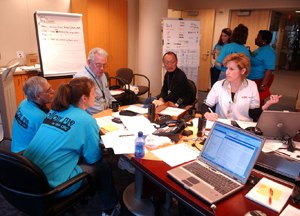
|
Jim Wilson and Yong-Duk Chyun join other Clinical Center staff in the move headquarters. Located in the Medical Board Room, the move headquarters served as the day’s planning, communication and coordination center.
|
|
|
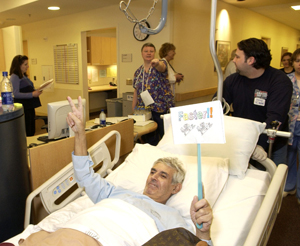
|
The adult oncology unit welcomed an enthusiastic George Mavrakis to the new facility.
|
|
- Kathryn Boswell
Back to Top
Safra Family Lodge opens for tours May 31 & guests June 1
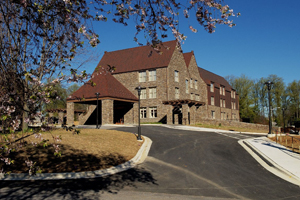
|
The exterior of the newly completed Edmond J. Safra Family Lodge.
|
The Edmond J. Safra Family Lodge at NIH, conceived as a house of refuge for loved ones of patients receiving care at the Clinical Center, will open on June 1.
NIH staff who would like a tour of the new Lodge and its gardens may visit May 31, between 11 a.m. and 1 p.m. The Lodge is located a short walk west of the CRC.
Dedication and opening ceremonies will take place May 26. Because of space limitations, attendance is by invitation only.
Construction on the Lodge, which features 34 guest rooms, began in 2003. A $4.5 million donation to NIH from The Edmond J. Safra Philanthropic Foundation allowed the construction of the Lodge to begin, along with the design and construction of a garden. Other contributors include the Merck Company Foundation, the Bristol-Myers Squibb Foundation, GlaxoSmithKline, the Harry and Jeanette Weinberg Foundation, and many more corporations, foundations and individuals.
Safra's wife, Lily, and the Foundation for NIH, hosted a ceremony marking the naming of the facility on April 17, 2002, at the Russell Senate Office Building in Washington , D.C.
For more information on the Family Lodge, call (301) 496-6500 or e-mail cc-familylodge@nih.gov.
- Sara Byars
Back to Top
Your guide to the new Clinical Center

Back to Top
Nurse educator Teresa Peduzzi retires
Teresa Peduzzi arrived at the Clinical Center in 1984 as a Nursing Department service-based educator in behavioral health. “I came here because I was fascinated by the work being done. I recognized the potential for what could be done in education here,” she says.
In 1994, she moved to the Nursing Department central education section and joined the standardization committee. In that role, she has been responsible for staff development—keeping the nursing staff up to date on products, regulatory changes and standards of practice.
Now, two decades later, Peduzzi is retiring from the career to which she has been so dedicated. She has served as an education consultant at NIH, coordinated and taught nursing classes, developed education programs, coordinated the nursing Code Blue program, developed the electronic review program for mandatory education in nursing, and served as the education coordinator to the Point of Care testing program.
In their farewell reflections, her colleagues had many kind things to say. “Teresa, I can never forget you and your compassion, encouragement and leadership. You were a guiding light for me,” says Janet Rowan. Peduzzi's friend and colleague Barbara Fahey says, “Teresa is worth her weight in gold, ten times over.”
Among all of her responsibilities at the Clinical Center, the project that Peduzzi is particularly proud of is her involvement with the Psychiatric Nursing Faculty Internship that she developed in 1991 to help academic faculty better understand mental illness so they could incorporate it into their curricula. “We invited faculty from all over the country to attend sessions, and once the program got started, it couldn't be stopped.” The one-week internship program eventually increased to 70 participants per program, with faculty participants traveling from as far as Africa, Canada , Hawaii and Sweden to take part.
Upon retirement, Peduzzi plans to spend more time with the people and things she loves most—her granddaughter, family members and her garden.
Back to Top
NIH authors applauded for ‘plain language’
The NIH Plain Language Committee recognized four Clinical Center projects with the annual Plain Language Awards for their notable efforts in using words that simplify a message, rather than complicate it.
From hundreds of submissions for the 2004 honors, the following Clinical Center projects were selected as the winners:
Outstanding
“Infection Control Guidelines Flipchart”
by Dr. David Henderson, Angela Michelin, Elizabeth Curnow, MaryAnn Bordner, Annette Booze, Jennifer Ball, Maggi White, Mickey Hanlon and Diane Croyle
Excellent
“History of the Clinical Center: Building Ten at Fifty”
by Pat McNees, Judy Rasminsky, Michael Dolan and Colleen Henrichsen
“Manuel del Paciente ‘Quartet” Spanish-language patient handbook
by Wendy Schubert
Honorable Mention
“Patient Handbook Quartet”
by Wendy Schubert
“Language Interpreting Service”
by Maria Radulovic
The winners were honored at the April 27 awards ceremony at Lipsett Amphitheater. The keynote speaker was acclaimed author and poet Judith Viorst.
Five years ago, NIH implemented the Plain Language Initiative to help address the need for clearer lang-uage in government communications. Through online training and educ-ation, NIH has continued to ensure that patients, employees and visitors understand every form, publication, video, magnet, poster and more.
To read more about the Plain Language Awards or to participate in the online training courses, visit http://execsec.od.nih.gov/plainlang/training/index.html.
Back to Top
New patient gate
A special entrance to the NIH campus for patients and their visitors has just opened. It is located at the intersection of West Cedar Lane and West Drive (near the Children's Inn and just north of the main entrance to the Mark O. Hatfield Clinical Research Center ).
The new entrance, which will be open 6 a.m. -7 p.m. weekdays (except holidays), is designed to provide patient-friendly access with one-stop security screening.
Clinical Center hospitality staff will be on site at the screening facility to assist patients. Go online for more information on this new resource at http://www.cc.nih.gov/about/visitor.shtml.
Back to Top
News briefs
Parking for Blood Bank has changed
Despite construction, the NIH Blood Bank is still open for business. Donors still receive two hours free parking and two hours of administrative leave, but getting there has changed. Donors must park in the lot directly across Center Drive . On foot, proceed to the well-marked entrance and follow the signs. Contact (301) 496-1048 or nihbloodbank@mail.cc.nih.gov to make an appointment.
Summer volunteers available
The Volunteer Center has many student-volunteers interested in serving in a Clinical Center office. Call Andrea Rander at (301) 496-1807 if you will need any student volunteers (16–20 years) during the summer months.
Back to Top
Clinical Center welcomes first admitted patient
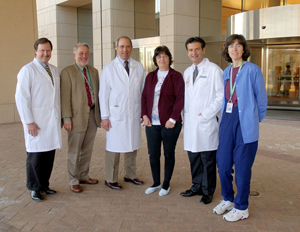
|
From left to right: Dr. Stephen G. Kaler, clinical director, NICHD; Dr. Owen M. Rennert, scientific director, NICHD; Dr. John Gallin, CC director, Phyllis L. Davis, the first new patient admitted to the Mark O. Hatfield Clinical Research Center; Dr. Constantine A. Stratakis, NICHD, Davis’ attending physician; and Mary Haughey, Davis’ primary nurse.
|
A Vermont resident with a devotion to helping others was the first new patient admitted to the newly opened Mark O. Hatfield Clinical Research Center.
Phyllis Davis of Barre arrived in admissions at 12:04 p.m. on Sunday, April 3, to participate in a protocol conducted by Dr. Constantine Stratakis, a National Institute of Child Health and Human Development investigator.
The study focuses on adrenal tumors and a group of rare and sometimes difficult to diagnose conditions known collectively as Carney Complex. More than 500 patient volunteers have participated in the clinical trial since it started in 1994. The goal is to confirm the diagnosis and map the inherited factors involved. Both aspects of the study, Stratakis explains, can help patients and their physicians better address potential health problems. Serious complications include heart and a variety of other tumors.
Dr. J. Aidan Carney, professor emeritus at Mayo Clinic College of Medicine, first reported the complex in the mid-1980s. “The disorder has multiple components,” said Carney, Stratakis' mentor and collaborator. “Any and all can occur by themselves and are not necessarily connected.”
Davis spent a week at the NIH Clinical Center . The protocol involves numerous blood draws, MRIs and other tests. She'll come back for follow up annually. “I'm doing this for a good reason,” Davis says. “What the doctors learn will make it easier for others.”
While here, Davis had a chance to explore the hospital, including the new chapel and recreation therapy's arts and crafts area. “I love working with my hands and have really enjoyed the arts and crafts. It's a beautiful building—roomy and airy.”
Her weeklong stay at the new hospital has meant a brief interruption to a project she holds dear. “I started ‘Precious Gifts of Love' after the tsunami last December. We are collecting stuffed animals for the children who survived. These little children need something to hold and be comforted by.” So far, Davis , helped by her daughter Justina, of Stafford , Va. , has collected more than a dozen boxes of cuddly critters.
In a sunny room on 5 West—on the south side overlooking the courtyard— Davis sits holding her stuffed bear. The bear is wearing a tiny NIH T-shirt. “I need my own stuffed animal to cuddle and hug,” she says, smiling.
For information on how to donate a stuffed animal to Precious Gifts of Love, contact CC Communications at, occc@cc.nih.gov. Nothing with batteries or with metal or hard plastic parts can be accepted.
- Sara Byars
Back to Top
CC employees receive NIH Hispanic Health Communications Award
José Rosado-Santiago, Social Work Department, and Dinora Dominguez, Patient Recruitment and Public Liaison Office, (pictured at right) were two of the seven recipients who received the Office of Communications and Public Liaison's NIH Hispanic Health Communications Initiative Award.
The two were recognized for their longtime volunteer service to the Hispanic Health Communications Initiative. Implemented in 1997, the initiative is designed to promote health and reduce health disparities in underserved Hispanic communities.
Rosado-Santiago has represented NIH at a series of Hispanic health fairs, distributing NIH and Clinical Center health education materials and speaking with Hispanic families. Dominguez was honored for her participation in a series of local and national radio broadcasts held each year, where she has informed listeners about the importance of Hispanics participating in clinical trials. “I am glad to work in an agency that is continually striving to excel in the production of high-quality Spanish-language materials and in reaching out to minorities,” says Rosado-Santiago.
Back to Top
Business Center opens in CRC
|
As a part of the ongoing efforts to meet the needs of patients and their families, the Clinical Center has opened a new business center.
Located on the first floor of the Hatfield Center, near the Rehabilitation Medicine Department, Room 1-2480, the center is open Monday–Friday, 9 a.m.–4 p.m.
Hospitality staff and volunteers stationed in the main north lobby of the Hatfield Center will provide access and help users. Four PCs and four MACs (all with Internet connection) as well as a combined printer/copier/FAX and telephones are available.
|
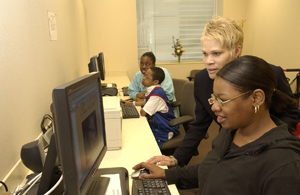 |
Pictured from right to left: LaKisha Noah, mother of patient Montrail Neil; Yasmin Coates, hospitality services coordinator; Montrail, patient; and Christine Spaulding, pediatric nurse.
|
|
Back to Top
Assistant Fire Marshal Paul Davis retires from NIH
Though his colleagues and friends celebrated his retirement from the NIH Division of the Fire Marshal, Office of Research Services, on April 1, 2005, don't expect to see Paul Davis hanging up his gear anytime soon. After a 25-year career in fire prevention and firefighting, Assistant Fire Marshal Davis is leaving NIH to enjoy more time with his family and to do more fishing, but his days as a firefighter are far from over.
At NIH, Davis has been responsible for fire safety training for Clinical Center employees, running fire-emergency evacuation drills, serving as the Building 10 fire protection inspector and a member of the Clinical Center Safety Committee, as well as serving with the NIH Fire Department as a firefighter.
“I'm one of the dinosaurs,” Davis quips. “Because I'm from the old school of firefighting, I work primarily as an assistant fire marshal by day, but I also work a 16-hour nightly tour of duty once a week with the firefighters at NIH Fire Department.”
NIH firefighters operating under federal requirements, maintain a 72-hour work week and are required to maintain many different certifications, which means Davis must keep all of his firefighting skills and certifications current and, in addition, be certified as an emergency medical technician in order to ride the fire truck. Davis does all this in addition to his technical and administrative duties as a NIH assistant fire marshal.
After retirement, Davis will continue to serve as a volunteer firefighter for the Walkersville Volunteer Rescue Company in his hometown of Walkersville , Md. , where he has been a volunteer chief and line officer for many years, and he will serve on the board of directors for the Walkersville Volunteer Fire Company. Davis also plans to continue pursuing his passion of fire safety training, educating other individuals and institutions on how they can protect themselves against the threat of fire.
“Firefighting is not just about fire suppression, it is also about prevention,” Davis says. “The engineering of a building and the science of fire prevention truly amazes me.”
Davis began his firefighting career in 1975 as a volunteer at the Gaithersburg Washington Grove Volunteer Fire Company. It was then that he became the fourth generation firefighter in his family.
“Paul Davis was a valuable team member of the Division of the Fire Marshal,” says J.P. McCabe, fire marshal for the Division of the Fire Marshal, Office of Research Services. “He possessed the people skills and initiative to be a great fire protection inspector and he was also an extremely loyal and dedicated employee. He will be sorely missed.”
Davis' wife, Brenda, and two sons, Adam and Brad, are pleased to have more family time together, while his NIH family wishes him the very best in his retirement.
“If I've done anything good at NIH, it has been fire safety education,” says Davis . All of those at NIH who have benefited from Davis ' expertise and work ethic know that he has done that and much more.
- Kathryn Boswell
Back to Top
A special thank you to the heroes behind the scenes
Every day, hundreds of NIH employees labor behind the scenes to keep the NIH Clinical Center clean, safe and functional. On the day of the move to the Hatfield Clinical Research Center, the nutrition staff had to unpack their cooking supplies while they simultaneously prepared meals for the new, incoming patients—and they did it with a smile, just like they always do. Each day, the housekeeping staff is on hand, making sure the patient care units are sparkling clean, while the facilities team ensures that every mechanical piece is running as intended. Without these employees and many others, the new Hatfield Center would not have the same energy and shine that it does. So, the next time you see one of these individuals or their co-workers, be sure to tell them a warm “thank you.”
|
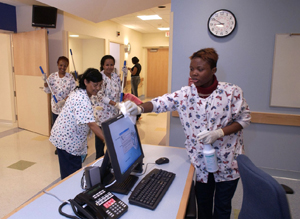
|
(l to r) Ayida Atistibha, Woine Hagos, Zerfe Agraw and Precious Moko
|
|
|

|
(l to r) Briant Lyles and Chauncey Buford
|
|

|
(l to r) Dorothy Martin and Cathy Worrell
|
Back to Top
May 2005 Upcoming Events
|
May 4
|
|
Noon–1 p.m. Lipsett Amphitheater
Grand Rounds
Hematopoietic Stem Cells as Vehicles for Therapeutic Gene Delivery in Disorders of Globin Synthesis
John Tisdale, M.D., Senior Clinical Investigator, Molecular and Clinical Hematology Branch, NIDDK
Epstein-Barr Virus Lymphoproliferative Diseases: From the Bedside to Bench
Jeffrey Cohen, M.D., Chief, Medical Virology Section, Laboratory of Clinical Infectious Diseases, NIAID
|
| May 6 |
|
10–11:30 a.m. Lipsett Amphitheater
Opening Ceremony, Nurses Week 2005 Panel Discussion: Transcultural Nursing
Bette Keltner, R.N., Ph.D., F.A.A.N., Dean, Georgetown University School of Nursing & Allied Health; Gihan El Gindy, M.S.N., R.N., Executive Director, Transcultural Education Center
|
| May 9 |
|
2–3 p.m. Building 10, Room 7-1580
Nurses Week 2005
So You Have an Idea for a Research Topic
Gwenyth Wallen, R.N., Ph.D., Section Chief/Clinical Nurse Specialist, Office of Research & Outcomes Mgmt.; Janice Yates, R.N., Ph.D., Clinical Nurse Scientist, Office of Research & Outcomes Mgmt.
|
| May 11 |
|
8:30–9:30 a.m. Building 10, Room 7-1580
Nurses Week 2005
So You Have an Idea for a Research Topic
Gwenyth Wallen, R.N., Ph.D., Section Chief/Clinical Nurse Specialist, Office of Research & Outcomes Mgmt.; Janice Yates, R.N., Ph.D., Clinical Nurse Scientist, Office of Research & Outcomes Mgmt.
Noon–1 p.m. Lipsett Amphitheater
Grand Rounds
Contemporary Clinical Medicine: Great Teachers
The Women's Health Study: What We Have Learned About Aspirin, Vitamin E, Heart Disease, and Cancer
Julie E. Buring, D.Sc., Professor of Epidemiology, Brigham and Women's Hospital
|
| May 12 |
|
11:30 a.m.–12:15 p.m. Building 10, B1 Level
Nurses Week 2005
Excellence in Clinical Nursing, Bedside Awards
Luncheon to follow, 12:15–3:30 p.m.
|
| May 18 |
|
Noon–1 p.m. Lipsett Amphitheater
Grand Rounds
Gene Identification in Parkinson Disease: Altering Understanding and Clinical Practice
Andrew Singleton, M.D., Chief, Molecular Genetics Unit, NIA
|
| May 25 |
|
Noon–1 p.m. Lipsett Amphitheater
Grand Rounds
Sweet But Not Innocent: Appropriate Care for Diabetes in 2005—Why We Care and Why You All Should Too
David Harlan, M.D., Chief, Islet and Autoimmunity Branch, NIDDK
Tricks of the Trade
Kristina I. Rother, M.D., Senior Staff Clinical Investigator, Islet and Autoimmunity Branch, NIDDK
|
|
* Some lectures can be accessed on the NIH videocast at http://videocast.nih.gov.
|
Back to Top
|


 The information on this page is archived and provided for reference purposes only.
The information on this page is archived and provided for reference purposes only.